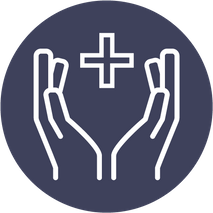
Physical Therapy for Ergonomic Assessment
AT EVOLVE
Physical Therapy for Ergonomic Assessments
WHAT IS ERGONOMICS?
Whether in advertising or in the workplace, most people have heard the term “ergonomics.” When an advertiser uses the word ergonomics, it usually accompanies an ad for a device made to fit or support an individual’s body more optimally. Ergonomics, the scientific study of people at work, is a subset of research that aims to reduce soft tissue and musculoskeletal disorders caused by one’s participation in repetitive tasks or postures in the workplace. If you find yourself rubbing your neck after a few hours at the computer or icing your wrist after a day spent at the job site, you may benefit from an ergonomic assessment.
The National Health Interview Survey (2015) found that between 14% and 21% of workers experienced low back pain, upper and lower extremity joint symptoms. While their employment may not be the cause of each episode of pain or symptoms, many individuals spend 40+ hours at their job each week and their working conditions can either help alleviate or exacerbate musculoskeletal and soft tissue symptoms. Work-related or work-exacerbated musculoskeletal and soft tissue symptoms can lead to lost wages, increased financial and psychosocial burden for an individual and loss of productivity amongst employers. Ergonomics aims to reduce the risk for developing these types of conditions. It may sound like ergonomics is something only large corporations implement, but in truth ergonomics can be utilized by anyone performing repetitive work.
HOW ARE PHYSICAL THERAPISTS INVOLVED IN ERGONOMICS?
HOW ARE PHYSICAL THERAPISTS INVOLVED IN ERGONOMICS?
Physical therapists play an important role in injury prevention. Their entry into the world of ergonomics allows them to provide specific injury-prevention strategies for workers and employees. As experts in the musculoskeletal system and in movement, physical therapists are naturally well-positioned to analyze the workplaces and activities of workers in the same way they do the movements and motions of an athlete.
Some physical therapists will pursue a certification in ergonomic assessment and prescription. These therapists are often brought in by employers to analyze a specific workplace or workflow either to address an individual employee’s symptoms or to optimize the ergonomics of an entire group of workers. Physical therapists who have not pursued a special certification in ergonomics will still educate their patients on adjustments they can make to their workspace to help limit exacerbation of a current injury or symptom and prevent new symptoms from arising in the future.
When performing an ergonomic assessment there are many aspects for a therapist to consider:
Frequency & duration: The dose and frequency of a particular activity or position is very important in determining whether it will cause unwanted soft tissue or musculoskeletal symptoms. For example, an employee that spends 7-8 hours seated at a desk will be much more likely to experience symptoms caused by an unsupportive chair than an employee that sits in the chair for 2-3 minutes at a time, 1-2x per hour. Similarly, how many breaks and how frequently a worker can take a break from their work is an important consideration as well.
Equipment and tools: Equipment and tools are very important when assessing workplace ergonomics. Workers that use hand tools or operate large equipment often perform repetitive motions. Some workers may perform two to three motions repeatedly throughout their entire shift with almost no variability. Even those that work at a computer are typing and mousing for hours at a time. Repetitive stress injuries can easily occur as a result of these repetitive motions.
Environmental organization: How a workplace is physically organized can increase or decrease the risk of developing a musculoskeletal or soft tissue injury. An employee that works at an L-shaped desk with one computer monitor in front of them and one to their left may be constantly turning their head and looking to the left in order to access data on the second screen. A grocery worker who is six foot four inches and who stands at the checkout counter may have to bend down all day to reach items on the belt.
Posture and performance: How a worker performs a task is just as important as how much and how often. Oftentimes the posture a worker assumes or the motions they use to complete a task are necessitated by the equipment they have available and how this equipment or their workstation is set up. Using one arm, for example, to perform a repetitive task without ever using the other can predispose that arm to injury. Twisting to move items from one location to another without also turning the feet can easily lead to pain over time. Looking down at a computer screen that is too low can lead to neck discomfort after 6-8 hours of work.
Workplace roles: Many employees have limited roles in the workplace and therefore tend to perform few tasks repetitively and sustain few postures for long periods of time. Those who switch activities and postures more frequently may be at less risk for developing work-related musculoskeletal or soft tissue symptoms than those who do not.
End Injury Progression
Ergonomics physical therapy has proven to prevent injury, slow and even stop pain issues, improve performance, and reverse injury progression in many cases.
Relieve Pain
The movements used in this technique can target your entire body helping you to manage discomfort and pain during the course of your physical therapy treatments.
Improve Range of Motion
Posture awareness is an important area to focus on due to the fact that certain positions may cause you further discomfort and pain.
Restore Mobility
You can regain mobility and flexibility by taking part in the stretches and exercises as prescribed by your physical therapist.
How Long Will Physical Therapy for Ergonomic Assessments Last?
If you decide to work with a physical therapist to help with ergonomics related issues, your entire treatment plan could consist of around 8-20+ different physical therapy sessions that will each last 60-90 minutes. Once you complete your customized physical therapy treatment plan, you will be able to continue to do the prescribed stretches and exercises utilized during your PT sessions yet in the comfort of your own home.
Looking for the cause of an injury
While full recovery and return to play is the ultimate goal when it comes to injury rehabilitation, a physical therapist has much more to offer. We are interested in identifying the factors that may have predisposed you to the injury in the first place so that we can make a plan to address them. This helps decrease your risk for future injury. Here are some factors that we look for when assessing a player:
- Muscle strength, power and endurance
- Flexibility and mobility in muscles and joints
- Sleep, nutrition and recovery time
- Training schedule
- History of prior injury
- The physical demands of a player’s position on the team
While some injuries are unavoidable, there may be times when internal and external factors play a role. Identifying these factors allows us to address them with a good physical therapy program or give advice on beneficial modifications to your training.
Movement and Performance Analyses
Over many years of studying the game of football, experts have determined the skills and components necessary for optimal performance. Being able to perform at your best requires that your body has enough strength, power, endurance, flexibility, etc. to not only perform your role on the field but also to manage the high training volumes on the field and in the training room. As movement experts, your physical therapist can assess your form with common training exercises like deadlifts, squats, plyometrics or running and give you insight on how to optimize the movements to enhance effectiveness and also decrease injury risk. Similarly, they can analyze common movement patterns utilized during play and determine if there are areas of weakness or impairments that should be addressed through a comprehensive training program.
So, if you are a football player who has never had an opportunity to work with a physical therapist we hope you can now see the many benefits of doing so. We want to work alongside your coaches, athletic trainers and family members to support your goals and dreams of excelling in football. Give us a call today to learn more about how we can help you take your athletic endeavors to the next level.
If you are dealing with a disc herniation and are ready to find a long-lasting solution to your pain call us today to learn more about our services and schedule an evaluation Call to Schedule a Consultation! 1-718-258-3300
Mill Basin (located in Harbor Fitness)
6161 Strickland Ave
Brooklyn, NY 11234
Monday: 7am-8pm
Tuesday: 7am-8pm
Wednesday: 8am-5pm
Thursday: 7am-8pm
Friday: 8am-1pm
Park Slope (located in Harbor Fitness)
550 5th Ave.
Brooklyn, NY 11215
Monday: 9am-8pm
Tuesday: 8am-6pm
Wednesday: 9am-8pm
Thursday: 8am-6pm
Friday: 8am-3pm
Gravesend
372 Avenue U
Brooklyn, NY 11223
Monday-Thursday: 8am-8pm
Friday: 8am-3pm
Ready to take the next step to a healthier you?
Contact Us Today!
PHYSICAL THERAPY FOR ERGONOMIC ASSESSMENTS!
Need physical therapy for Ergonomic Assessments?
Let our caring and compassionate physical therapists help you with relieving pain while getting you back on your feet comfortably.
Call now to schedule your first PT consultation free of charge.
Call: 1-718-258-3300







